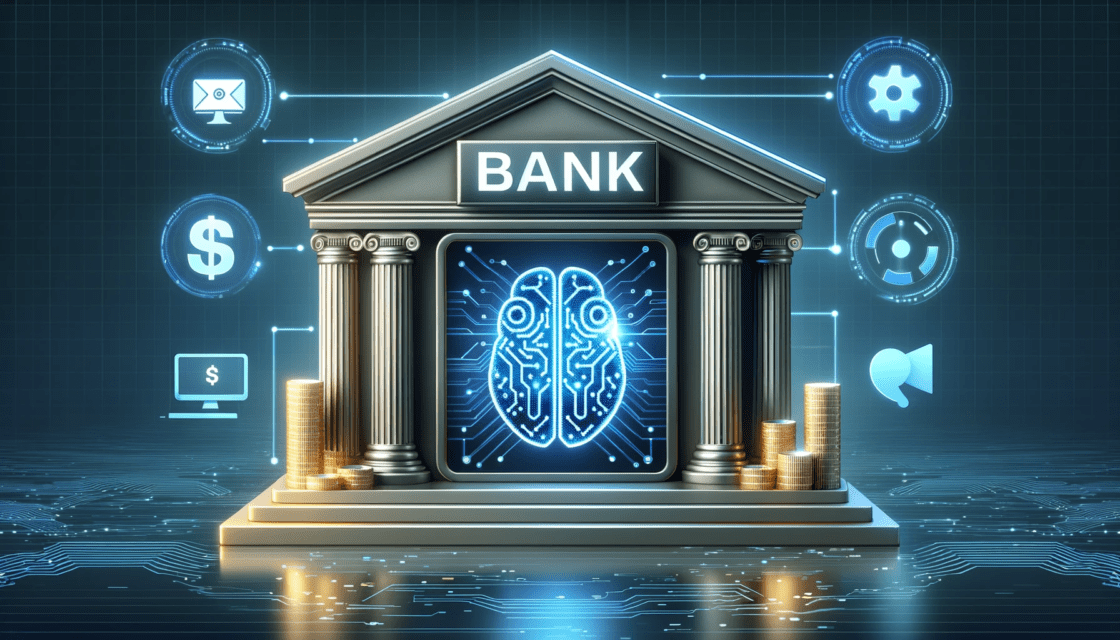Artificial Intelligence (AI) is a branch of computer science that aims to create machines capable of intelligent behavior. It encompasses various technologies like machine learning, natural language processing, and robotics, among others. AI has the potential to mimic human intelligence, learn from data, and automate complex tasks, thereby revolutionizing various industries, including banking.
This article aims to provide a comprehensive overview of the current state of AI in banking, the need for its integration in traditional banks with legacy systems, and a glimpse into what the future holds.
As we stand on the brink of 2024, the banking industry finds itself at a pivotal juncture. The sector is undergoing a transformative shift, driven by technological advancements and changing consumer expectations. At the heart of this transformation is Artificial Intelligence (AI), a technology that promises to redefine the very fabric of banking operations and customer interactions.
Brief on the Current State of AI in Banking
The adoption of AI in banking is not a futuristic concept but a present-day reality. According to a report by Emerj, leading U.S. banks have already embraced AI for a multitude of applications, ranging from customer service and fraud detection to risk management and predictive analytics. The technology is making its presence felt across the banking ecosystem. For instance, Bank of America’s AI-driven chatbot, Erica, serves over 10 million users, providing real-time financial advice and transactional support.
The investment in AI technologies by banks is also seeing an upward trajectory. A study by Autonomous Research estimates that financial institutions could save up to $1 trillion by 2030 through the adoption of AI and automation. These numbers are not just impressive; they are indicative of the seismic shift that AI is bringing about in the banking sector.
The Need for AI Integration in Traditional Banks with Legacy Systems
While the adoption of AI is accelerating, it’s essential to note that a significant portion of the banking industry still operates on legacy systems. These are outdated software and hardware infrastructures that were built decades ago and are not equipped to handle the complexities and demands of modern-day banking. The challenge, therefore, lies in integrating AI technologies into these legacy systems without disrupting existing operations.
The need for this integration is not just driven by competitive pressures but also by evolving regulatory frameworks. As we move towards a more digitized world, regulatory bodies are tightening the screws on data management and customer privacy. AI can play a crucial role in helping banks navigate these regulatory mazes, offering solutions that are not just efficient but also compliant with legal requirements.
The COVID-19 pandemic has accelerated the need for digital transformation. Customer behaviors have changed, and there is an increasing demand for remote and personalized banking services. Technology providers can fill this gap by providing customized solutions, like Latinia, that can be easily integrated into existing legacy systems, thereby enhancing both operational efficiencies and customer experiences.
The integration of AI into traditional banking systems is not just a technological upgrade; it’s a strategic imperative. As we approach 2024, banks that successfully integrate AI into their operations will not just stay ahead of the curve; they will redefine it.
The AI Landscape in Banking
The adoption of AI in the banking industry is a multifaceted approach that touches various aspects of banking operations. Here are some of the key areas where AI is making a significant impact in top U.S banks:
Customer Service: AI-driven chatbots like Bank of America’s Erica and Wells Fargo’s predictive banking services are revolutionizing the way banks interact with their customers. These chatbots can handle a multitude of tasks, from answering transaction queries to providing financial advice.
Fraud Detection: AI algorithms are increasingly being used to monitor transaction patterns in real-time, flagging suspicious activities and reducing the risk of fraud. CitiBank, for instance, employs AI in its anti-money laundering initiatives.
Risk Management: AI is also playing a pivotal role in assessing and managing risks. Algorithms can analyze vast amounts of data to predict market trends, thereby aiding in investment decisions.
Predictive Analytics: Banks like US Bank are leveraging AI to analyze customer behavior and offer personalized financial products. This not only enhances customer satisfaction but also increases cross-selling opportunities for the bank.
These applications are just the tip of the iceberg. As AI technologies continue to evolve, their scope and impact on the banking industry are expected to grow exponentially.
Investment Trends in AI by Banks
Several venture capital firms are showing keen interest in AI startups that focus on financial services. This influx of capital is enabling these startups to develop innovative solutions that can easily be integrated into the banking ecosystem.
Moreover, banks are not just investing in external ventures; they are also setting up in-house AI research labs to develop customized solutions. This dual approach ensures that banks are not just consumers of AI technology but also contributors to its advancement.
The AI landscape in banking is both dynamic and promising. As we inch closer to 2024, the integration of AI into the banking sector is set to accelerate, driven by both technological advancements and strategic investments. The future, it seems, is not just automated; it’s intelligent.

Challenges in AI Adoption
While the promise of AI in banking is immense, the path to full-scale adoption is not without its challenges. From talent management to technological compatibility, banks face a myriad of obstacles that need to be addressed to unlock the full potential of AI.
Talent Acquisition and Retention
One of the most significant challenges in AI adoption is the scarcity of talent. AI is a specialized field that requires a unique skill set, including expertise in machine learning, data analytics, and software development. According to a report by Emerj, the demand for AI specialists in the banking sector far outstrips the supply.
Moreover, retaining this talent is another hurdle. The tech industry, especially companies like Google and Amazon, offers lucrative packages and career growth opportunities that are often more appealing than those in the banking sector. Banks, therefore, need to not only attract but also retain top talent by offering competitive salaries, continuous learning opportunities, and a conducive work environment.
Compatibility with Legacy Systems
The second major challenge is the compatibility of AI technologies with existing legacy systems. Many traditional banks operate on outdated software and hardware infrastructures that were not designed to support the complexities of modern AI algorithms. The integration of AI into these systems can be both time-consuming and costly.
However, the challenge is not insurmountable. Solutions like API-based integrations and middleware platforms can act as a bridge between legacy systems and new-age AI technologies. Banks can also opt for modular AI solutions that can be incrementally integrated into existing systems, thereby minimizing operational disruptions.
The key lies in adopting a phased approach, starting with less complex AI applications and gradually moving towards more advanced solutions as the system stabilizes.
AI Use Cases in Banking
The transformative power of AI in banking is best understood through its diverse range of applications. These use cases not only enhance operational efficiency but also significantly improve customer experience.
Fraud Detection and Risk Management
In an era where cyber threats are increasingly sophisticated, the role of AI in fraud detection and risk management is indispensable. AI algorithms can analyze transaction patterns in real-time, flagging suspicious activities and reducing the risk of fraud. For instance, CitiBank employs AI in its anti-money laundering initiatives, using machine learning algorithms to identify unusual transaction behaviors that could indicate fraudulent activities.
The benefits extend beyond just fraud detection. AI can also be used to assess credit risks, thereby aiding banks in making more informed lending decisions. The technology can analyze a plethora of data points, from credit scores to spending habits, to predict the likelihood of a borrower defaulting on a loan.
Customer Service Chatbots
Customer service is another domain where AI is making significant strides. AI-driven chatbots like Bank of America’s Erica and Wells Fargo’s predictive banking services are revolutionizing the way banks interact with their customers. These chatbots can handle a multitude of tasks, from answering transaction queries to providing financial advice.
The impact on customer experience is profound. According to a Forbes article, AI chatbots can handle up to 80% of routine customer queries, freeing up human agents to focus on more complex issues. This not only enhances operational efficiency but also significantly improves customer satisfaction.
Predictive Analytics
Predictive analytics is another compelling use case for AI in banking. Banks like US Bank are leveraging AI to analyze customer behavior and offer personalized financial products. These predictive models can forecast future spending patterns, recommend suitable financial products, and even predict customer churn.
The benefits are twofold: customers get a more personalized banking experience, and banks get increased cross-selling opportunities. It’s a win-win situation that exemplifies the transformative power of AI in banking.
The use cases for AI in banking are as diverse as they are impactful. As we move closer to 2024, these applications are set to become more advanced and ubiquitous, shaping the future of banking in ways we can only begin to imagine.
AI in Wells Fargo and Bank of America
As we explore the landscape of AI in banking, it’s essential to zoom in on some of the industry leaders who are setting benchmarks in AI adoption. Wells Fargo and Bank of America stand out as pioneers in leveraging AI to enhance both operational efficiencies and customer experiences.
Predictive Banking in Wells Fargo
Wells Fargo is at the forefront of predictive banking, a revolutionary concept that aims to offer personalized financial advice to customers based on their spending habits, income, and financial goals. The bank employs sophisticated AI algorithms that analyze a customer’s financial history and current transactions to offer real-time insights and recommendations.
For example, if the algorithm detects a pattern of high utility bills during winter months, it may suggest budgeting tips or even recommend energy-efficient home improvements. This proactive approach not only helps customers manage their finances better but also fosters a deeper relationship between the bank and its customers.
Erica, the Chatbot from Bank of America
Bank of America’s AI-driven chatbot, Erica, is another shining example of AI’s transformative power in banking. Launched in 2018, Erica serves over 10 million users and handles a wide range of tasks, from transaction queries and bill payments to providing personalized financial advice.
What sets Erica apart is its ability to learn from user interactions. The chatbot employs machine learning algorithms to understand user behavior and preferences, thereby offering increasingly personalized and relevant advice over time. This level of customization enhances customer satisfaction and sets a new standard for AI-driven customer service in banking.
Wells Fargo and Bank of America are not just adopting AI; they are shaping its future in the banking industry. Their innovative approaches serve as case studies for other banks looking to embark on their own AI journeys. As we approach 2024, these initiatives offer a glimpse into the future of banking—a future that is not just automated but also deeply personalized and customer-centric.
AI in CitiBank and US Bank
Continuing our exploration of AI pioneers in the banking sector, CitiBank and US Bank offer compelling case studies in how AI can be leveraged for both security and customer engagement. Each bank has carved out its niche in the AI landscape, focusing on areas that align with their strategic objectives and customer needs. This section will delve into the specific AI initiatives of CitiBank and US Bank.
Fraud and Anti-Money Laundering in CitiBank
Security is a paramount concern in the banking industry, and CitiBank is leveraging AI to bolster its fraud detection and anti-money laundering efforts. The bank employs advanced machine learning algorithms that continuously monitor transactions to identify suspicious activities. These algorithms are trained on vast datasets, enabling them to distinguish between legitimate and potentially fraudulent transactions with high accuracy.
For instance, if a series of large withdrawals are made in a short period, the system flags it for further investigation. This real-time monitoring significantly reduces the risk of financial fraud and ensures compliance with anti-money laundering regulations. By integrating AI into its security protocols, CitiBank is setting a new industry standard for financial security.
Predictive Analytics in US Bank
US Bank is making strides in the realm of predictive analytics, using AI to offer tailored financial products to its customers. The bank employs AI algorithms that analyze customer behavior, spending patterns, and financial history to predict future financial needs. Based on these insights, the bank can proactively offer relevant financial products, such as loans or investment options, that align with the customer’s financial goals.
For example, if the algorithm detects a pattern of increased spending on home improvement, it may suggest a home equity line of credit as a financing option. This proactive approach not only enhances customer satisfaction but also opens up new revenue streams for the bank through targeted cross-selling.
CitiBank and US Bank offer valuable insights into the diverse applications of AI in banking, from enhancing security protocols to personalizing customer experiences. Their initiatives serve as a roadmap for other banks looking to integrate AI into their operations. As we inch closer to 2024, these case studies underscore the transformative potential of AI in shaping the future of banking.

The Role of Latinia in AI Banking
While Latinia may not be an AI company per se, its real-time decision-making solutions are a crucial component in the modern banking ecosystem. Latinia is a Business Rules Management System that enables real-time communications based on transactional events and data.
Latinia’s Solutions for Traditional Banks
Latinia offers a range of solutions designed to transform every financial transaction into an opportunity for meaningful customer engagement. Their real-time decision engines analyze financial events in real-time, allowing banks to be proactive in their customer interactions. For instance, Latinia’s “Next Best Action” (NBA) engine enables banks to engage customers based on their transaction events, offering personalized products and anticipating client needs.
Moreover, Latinia’s solutions are highly customizable, allowing banks to build notification services based on customer transaction activity and preferences. This reduces unsolicited communication and enhances customer knowledge, thereby improving the overall customer experience.
Latinia has successfully implemented its solutions across various banks, demonstrating the tangible benefits of real-time decision-making in banking. Their scalable infrastructure is particularly effective in managing real-time critical transactional banking notifications, including OTP processes, digital signatures, and security alerts. This ensures that clients never miss sensitive banking information, thereby enhancing trust and compliance.
Latinia’s solutions are trusted by many banks for their robustness, flexibility, and scalability. They perfectly fit into new omnichannel architectures, making them an ideal partner for banks looking to modernize their communication strategies.
Latinia is playing a pivotal role in shaping the future of real-time banking experiences. As we move towards 2024, the integration of Latinia’s solutions together with AI technologies will likely become more prevalent, offering a more holistic and customer-centric approach to banking.
Future Trends in AI in Banking: A 2024 Outlook
As we venture into the future, the banking industry is poised for transformative changes, especially with the integration of Artificial Intelligence (AI).
AI-Driven Customer Profiling
Financial institutions are increasingly adopting AI-driven solutions in anti-money laundering (AML) and know-your-customer (KYC) processes. These technologies not only speed up the verification process but also enhance precision in customer profiling. The AI algorithms can analyze vast amounts of data to identify suspicious activities or inconsistencies, thereby improving the overall security and efficiency of banking operations.
Generative AI and Cloud Technologies
Generative AI is breaking new ground in the banking sector. This technology, coupled with the sweeping embrace of cloud technologies, is setting a new pace for the industry. Generative AI can create new data that is similar to the training data, which can be particularly useful for simulating different financial scenarios or fraud detection. The cloud infrastructure, on the other hand, provides the necessary scalability and flexibility for these advanced AI models.
Real-Time Analytics and Personalization in Communications
In an era where customer expectations are at an all-time high, real-time analytics and personalized communications are becoming indispensable for banks. These technologies enable financial institutions to offer targeted services and products based on real-time customer behavior and preferences. For instance, if a customer frequently transfers money abroad, the bank could offer them a specialized international transfer service with reduced fees.
Latinia, a leader in business rules management systems for banking, is at the forefront of this trend. While not strictly an AI company, Latinia makes real-time communications based on transactional events and data possible. This level of personalization not only enhances customer experience but also opens up new avenues for revenue generation for banks.
By leveraging real-time analytics and personalized communications, banks can not only improve customer engagement but also gain a competitive edge in the rapidly evolving financial landscape.
Open Banking and APIs
Open banking is reshaping how banks interact with their customers and third-party service providers. Through Application Programming Interfaces (APIs), banks can offer a broader array of services, fostering innovation and leading to new financial products that cater to specific customer needs. This approach simplifies processes like account aggregation, expense tracking, and credit scoring, thereby benefiting both consumers and businesses.
Data Analytics and AI-Driven Insights
The era of big data has opened new avenues for banks to gain insights into customer behavior. Predictive analytics is increasingly being used for risk assessment, enabling banks to make informed decisions about lending and investments. AI-driven solutions are also transforming fraud detection by identifying unusual patterns and alerting banks to potential security threats (Source).
These trends offer a glimpse into the future of AI in banking, highlighting both the opportunities and challenges that lie ahead. As we approach 2024, these trends are likely to become focal points for innovation and adaptation in the banking sector.

Conclusion
As we stand on the cusp of 2024, the integration of Artificial Intelligence (AI) into the banking sector is no longer a futuristic concept but a present-day reality. This article has traversed the landscape of AI in banking, highlighting its current applications, challenges, and future trends. From fraud detection and customer service enhancements to predictive analytics and real-time personalization, AI is revolutionizing the way banks operate and interact with their customers.
Summary of Key Takeaways
AI Applications: Major banks like Wells Fargo, Bank of America, CitiBank, and US Bank are already leveraging AI for various applications, including fraud detection, customer service, and predictive analytics.
Challenges: Talent acquisition, compatibility with legacy systems, and regulatory changes are some of the hurdles that banks need to overcome for successful AI integration.
Future Trends: The future holds exciting possibilities, including advanced customer profiling, generative AI, blockchain integration, and real-time analytics. These trends are set to redefine the banking experience, making it more secure, efficient, and personalized.
Recommendations for Banks Considering AI Adoption
Start Small, Think Big: Begin with specific use-cases like fraud detection or customer service chatbots and gradually expand to other areas as you gain expertise and confidence.
Invest in Talent: Skilled professionals in data science and machine learning are essential for the successful implementation and maintenance of AI systems.
Regulatory Compliance: Keep an eye on the evolving regulatory landscape to ensure that your AI initiatives are in compliance with legal requirements.
Partner with Experts:In the complex journey of AI adoption, partnering with experts is invaluable. They offer strategic guidance to identify high-impact use-cases, ensuring your AI initiatives align with your business goals. Their technical expertise can help you make informed decisions on AI technologies, while their understanding of regulatory compliance mitigates risks. Experts also assist in seamless implementation and scaling, providing ongoing support for continuous optimization.
Customer-Centric Approach: Always keep the customer at the heart of your AI initiatives. Personalization and real-time analytics are key to improving customer satisfaction and loyalty.
In conclusion, the adoption of AI in banking is not just a technological shift but a strategic imperative. As we move closer to 2024, banks that embrace AI and partner with experts like Latinia will be better positioned to navigate the complexities of the modern financial landscape.
Categories: Trends

